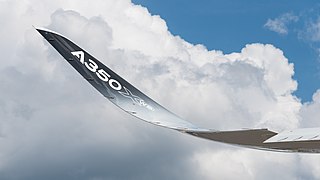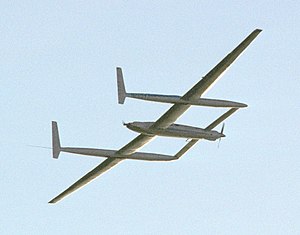
Scaled Composites is an American aerospace company founded by Burt Rutan and currently owned by Northrop Grumman. It is located at the Mojave Air and Space Port in Mojave, California, United States. Founded to develop experimental aircraft, the company now focuses on designing and developing concept craft and prototype fabrication processes for aircraft and other vehicles. It is known for unconventional designs, for its use of non-metal, composite materials, and for winning the Ansari X Prize with its experimental spacecraft SpaceShipOne.

Wingtip devices are intended to improve the efficiency of fixed-wing aircraft by reducing drag. Although there are several types of wing tip devices which function in different manners, their intended effect is always to reduce an aircraft's drag. Wingtip devices can also improve aircraft handling characteristics and enhance safety for following aircraft. Such devices increase the effective aspect ratio of a wing without greatly increasing the wingspan. Extending the span would lower lift-induced drag, but would increase parasitic drag and would require boosting the strength and weight of the wing. At some point, there is no net benefit from further increased span. There may also be operational considerations that limit the allowable wingspan.

Elbert Leander "Burt" Rutan is a retired American aerospace engineer and entrepreneur noted for his originality in designing light, strong, unusual-looking, and energy-efficient air and space craft. He designed the record-breaking Voyager, which in 1986 was the first plane to fly around the world without stopping or refueling. He also designed the Virgin Atlantic GlobalFlyer, which in 2006 set the world record for the fastest and longest nonstop non-refueled circumnavigation flight in history. In 2004, Rutan's sub-orbital spaceplane design SpaceShipOne became the first privately funded spacecraft to enter the realm of space, winning the Ansari X-Prize that year for achieving the feat twice within a two-week period.

Jeana Lee Yeager is an American aviator. She co-piloted, along with Dick Rutan, the first non-stop, non-refueled flight around the world in the Rutan Voyager aircraft from December 14 to 23, 1986. The flight took 9 days, 3 minutes, and 44 seconds and covered 24,986 miles (40,211 km), almost doubling the old distance record set by a Boeing B-52 strategic bomber in 1962.

Richard Glenn Rutan was an American military aviator and officer. He was also a record-breaking test pilot who in 1986 piloted the Voyager aircraft on the first non-stop, non-refueled around-the-world flight with co-pilot Jeana Yeager. Rutan was born and raised in Loma Linda, California, where he gained an interest in flying at a young age. He was the older brother of famed aerospace designer Burt Rutan, whose many earlier original designs Dick piloted on class record-breaking flights, including Voyager.

The Scaled Composites Model 311 Virgin Atlantic GlobalFlyer is an aircraft designed by Burt Rutan in which Steve Fossett first flew a solo nonstop airplane flight around the world in slightly more than 67 hours in 2005. The flight speed of 342 miles per hour (550 km/h) set the world record for the fastest nonstop non-refueled circumnavigation, beating the mark set by the previous Rutan-designed Voyager aircraft at 9 days 3 minutes with an average speed of 116 miles per hour (187 km/h).

The Mojave Air and Space Port at Rutan Field is in Mojave, California, United States, at an elevation of 2,801 feet (854 m). It is the first facility to be licensed in the United States for horizontal launches of reusable spacecraft, being certified as a spaceport by the Federal Aviation Administration on June 17, 2004. The facility covers 2,998 acres and has three runways.

The Rutan Model 61 Long-EZ is a tandem 2-seater homebuilt aircraft designed by Burt Rutan's Rutan Aircraft Factory. The Long-EZ has a canard layout, a swept wing with wingtip rudders, and a pusher engine and propeller. The tricycle landing gear has fixed main wheels with streamlined spats and a retractable nosewheel. Its predecessor was the VariEze, plans for which were first available to homebuilders in 1976. The prototype Long-EZ, N79RA, first flew on June 12, 1979.

The Rutan VariEze is a composite, canard aircraft designed by Burt Rutan. It is a high-performance homebuilt aircraft, hundreds of which have been constructed. The design later evolved into the Long-EZ and other, larger cabin canard aircraft. The VariEze is notable for popularizing the canard configuration and moldless glass cloth composite construction for homebuilt aircraft.

The Adam A500 is an American six-seat civil utility aircraft that was produced by Adam Aircraft Industries. The aircraft is of pod-and-boom, push-pull configuration with its two Continental TSIO-550-E piston engines mounted to provide centerline thrust.

The Rutan Model 54 Quickie is a lightweight single-seat taildragger aircraft of composite construction, configured with tandem wings.

The Rutan Model 40 Defiant is a four-seat, twin-engine homebuilt aircraft with the engines in a push-pull configuration. It was designed by aerospace engineer Burt Rutan for the Rutan Aircraft Factory.

The Scaled Composites ARES is a demonstrator aircraft built by Scaled Composites. ARES is an acronym for Agile Responsive Effective Support.

The Berkut 360 is a tandem-seating, two-seat homebuilt canard aircraft with pusher configuration and retractable landing gear, built primarily of carbon fiber and fiberglass.

The Rutan VariViggen is a homebuilt aircraft designed by Burt Rutan. The aircraft is a tandem two-seater of primarily wooden construction with a delta wing and a canard foreplane. The VariViggen is powered by a 150 hp Lycoming O-320 aero engine in pusher configuration. The prototype was designated Model 27, and the production version was Model 32.

The AMSOIL Racer, also known as the Rutan Biplane Racer and the Rutan Model 68 Racer, was a race tandem wing plane which was designed by Burt Rutan's Rutan Aircraft Factory, and built and flown by Dan Mortensen. It set several speed records, but crashed at the 1983 Reno Air Races.

The Rutan Model 77 Solitaire is an American, single seat, canard, mid-wing motor glider that was developed by Burt Rutan in response to the 1982 Sailplane Homebuilders Association Design Contest for a homebuilt glider. It first flew in 1982. The Solitaire was declared the winner of the contest and its unusual layout attracted a great deal of attention. For a time in the 1980s the aircraft was available as plans and as a kit.

The Garrison Melmoth 2 is the second aircraft design from author Peter Garrison.

The Quickie Q2 or Q2 is a two-seat version of the unique Rutan Quickie, produced in kit form by the Quickie Aircraft Corporation founded by Tom Jewett and Gene Sheehan. Canadian Garry LeGare was involved in the design.

The Dickey E-Racer, also called the Sierra Delta E-Racer, is an American homebuilt aircraft that was designed by Shirl Dickey and produced by Shirl Dickey Enterprises of Phoenix, Arizona. It was first flown in 1984. When it was available the aircraft was supplied in the form of plans for amateur construction, with some parts available to facilitate faster construction.























